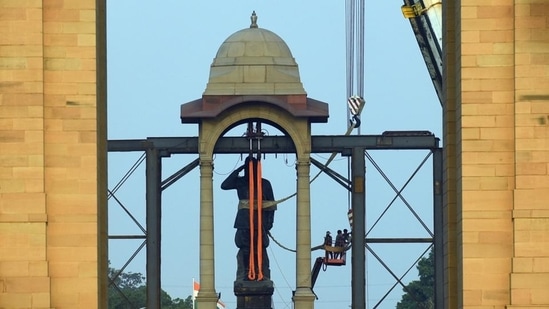100-feet-long truck, single granite block used for Netaji statue | 5 points
The statue of Netaji Subhas Chandra Bose has been installed in the same place where a hologram statue of Netaji was unveiled earlier this year on Parakram Diwas.
Prime Minister Narendra Modi is set to unveil a 28-feet tall statue of India’s iconic freedom fighter Netaji Subhas Chandra Bose today under the canopy near India Gate. The jet black granite statue will replace a hologram statue of Netaji that was unveiled earlier this year on Parakram Diwas to mark his 125th birth anniversary. PM Modi had assured that a grand statue of Netaji made of granite will be installed at India Gate as a symbol of the nation’s indebtedness to him.

PM Modi’s arrival at the canopy will be heralded with traditional Manipuri Shankh Vadayam and Kerala’s traditional Panch Vadayam and Chanda. The unveiling of the statue would be accompanied by the tune of Kadam Kadam Badhaye Jaa, the traditional song of the Azad Hind Fauj, an armed force that Bose headed during the fight for independence from British rule.
A special 10-minute drone show on Netaji’s life would be projected at India Gate at 8.00pm from September 9-11. The drone show would be open to the public with free entry.
Here’s all you need to know about Netaji’s statue:
The grand statue – one of the tallest, realistic, monolithic, handmade sculptures in India – has been carved from a monolithic block of granite weighing 280 metric tonnes.
It took over 26,000 man hours of intense artistic endeavor to produce a statue weighing 65 MT by chiseling the huge granite monolith.
The monolithic granite stone was carried by a 100-feet-long truck with 140 wheels, specially designed for this purpose. The stone travelled 1,665km from Khammam in Telangana to New Delhi.
A team led by Arun Yogiraj, a fifth-generation sculptor from Mysuru, hand sculpted the statue using traditional techniques and modern tools.
The canopy under which the statue has been placed previously featured a bust of Britain's King George V, which was removed in 1968. For decades, the canopy housed the Amar Jawan Jyoti, which was merged with the eternal flame of the National War Memorial Torch on Republic Day.






